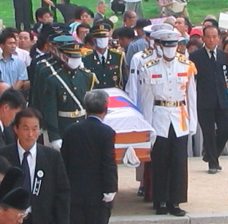 Jonathan Dresner just brought up the recent funeral of Yi Ku here in Seoul, where I’m spending the summer. Yi Ku is an interesting individual who, like so many of the last royal family members of the Qing dynasty and Korean royal family became closely connected to the Japanese imperial family and the fate of the Japanese empire. Yi’s mother was the Japanese princess Nashimoto Masako (Yi Pang-ja), a cousin of the current Japanese emperor Akihito’s mother. You can see a little chart to see how this connects with Korea’s famous last king Kojong.
Jonathan Dresner just brought up the recent funeral of Yi Ku here in Seoul, where I’m spending the summer. Yi Ku is an interesting individual who, like so many of the last royal family members of the Qing dynasty and Korean royal family became closely connected to the Japanese imperial family and the fate of the Japanese empire. Yi’s mother was the Japanese princess Nashimoto Masako (Yi Pang-ja), a cousin of the current Japanese emperor Akihito’s mother. You can see a little chart to see how this connects with Korea’s famous last king Kojong.
The funeral was apparently attended by the Japanese Ambassador (Urabe Toshinao) and even a representative of the Japanese Imperial family, Nashimoto Takano. His ex-wife Julia Mullock, who Yi may have been pressured into divorcing by family members when she didn’t produce an heir was not invited and was apparently across the street when the funeral took place at Cheongdeok palace. There may be a movie about her life coming out at some point.
It just so happened that, completely oblivious to this whole thing, I stumbled into the crowds in front of Cheongdeok palace as the funeral for Yi Ku was wrapping up and they were carrying the coffin out. I was there to go on a tour of the palace grounds with a friend. It was a kind of strange scene, actually. The crowd seemed very curious but I didn’t see much outpouring of emotion. Even the performance of many of those dressed up in Joseon period costumes was less than inspiring and they seemed to slouch and be less than enthused about participating in this funeral. I suspect that the ambivalent emotions surrounding a royal family so tainted by its connections to the Japanese imperial family and the fact that family members such as Yi Ku were often born, raised, or made Japan their home may have a lot to do with this.
We bought tickets for the tour but the entrance where the tour meets was packed with yellow-clad and pink-feathered women and costumed men with various banners. I asked the lady at the ticket booth if she was sure there was a tour being given in the middle of all this and that I could just walk through this entrance but she assured me everything was fine. Eventually, after much swimming through the crowd, we joined some 30 other foreigners at the main gate, even as the procession was continuing to pour out. Our tour guide gathered us together and again making our way through the crowd we went in through the back door. She mentioned the funeral only twice during the tour, to tell us that a royal family member had died and that “it was all over now.” She seemed to be relieved and our tour was business as usual in all other respects. Our tour passed by the site of the reception on the lawn outside one of the palace buildings, where the crew was still packing up seats and taking down signs guiding foreign dignitaries to their respective sections. Yi Ku’s portrait was leaning up against a palace wall. I posted a few pictures of the funeral scene for viewing here. If you are interested, I have also posted some pictures of the beautiful palace grounds where the funeral was held (and Yi Ku lived for a number of years in the 60s and 70s) here.
Korea Times: Son of Choson’s Last Prince Dies
Longer Korea Times Article: Turbulent History Agonizes Royal Family – Lots of background on the family and Yi’s life.
United Press International Article – Notes that his ex-wife (an American Julia Mullock) was apparently banned from the funeral and had to watch it from across the street.
Donga Article – Tragic Grandson of Joseon Royal Family, RIP
“Joseon” Is that the new romanization I need to learn?
I didn’t realize that he was a member of both lines.
Awesome pics!
Joseon – Doh, I was mixing romanization in my posting….I really should settle on which to use – we saw both in my classes…but I think the spelling you are used to is probably better to stick to…
Mitch, do you remember that we talked about the confusing romanization of chinese, especially the Wade-Gyles? I came to realize that the Korean romanization is much more “messed up”, and even the Koreans do not follow the newly established standard :(.
Korean romanization is a bit confusing, especially since (like many overseas Chinese and those with a lot of overseas contacts) there is little standardization with names. I am also not sure whether the academics have really adopted the new system or not since I see both the old (R-M system) and new standard in papers…I should at least pick one and stick with it though…